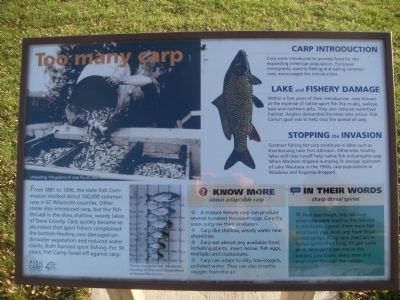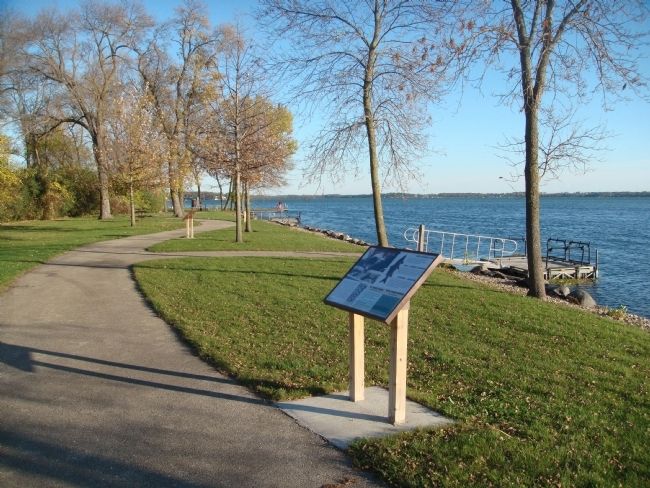Near McFarland in Dane County, Wisconsin — The American Midwest (Great Lakes)
Too many carp
Carp Introduction
Carp were introduced to provide food for the expanding American population. European immigrants, used to fishing and eating common carp, encouraged the introduction.
Lake and Fishery Damage
Within a few years of their introduction, carp thrived at the expense of native sport fish like musky, walleye, bass and northern pike. They also reduced waterfowl habitat. Anglers demanded the state take action. Fish Camp's goal was to help stop the spread of carp.
Stopping the Invasion
Contract fishing for carp continues in lakes such as Koshkonong near Fort Atkinson. Otherwise, healthy lakes with less runoff help native fish outcompete carp. When Madison stopped dumping its sewage upstream of Lake Waubesa in the 1950s, carp populations in Waubesa and Kegonsa dropped.
Know More about adaptable carp
° A mature female carp can produce several hundred thousand eggs. Carp fry soon outgrow their predators.
° Carp like shallow, weedy water near shorelines.
° Carp eat almost any available food, including plants, insect larvae, fish eggs, mollusks and crustaceans.
° Carp can adapt to silty, low-oxygen, polluted water. They can also breathe oxygen from the air.
In Their Words sharp dorsal spines
"That was tough, too, because when you were loading this net out in the holding pond there were fish all around you. And carp have those dorsal spines. A big carp [has] upper dorsal spines that long, it's got barbs on it. And you'd get one in the waders, you know, every now and then, right through the rubber waders."
Erected by Dane County Parks.
Topics. This historical marker is listed in these topic lists: Environment • Industry & Commerce • Sports. A significant historical year for this entry is 1881.
Location. 42° 58.951′ N, 89° 15.868′ W. Marker is near McFarland, Wisconsin, in Dane County. Marker can be reached from Fish Camp Road, 0.4 miles east of County Highway AB, on the right when traveling east. The marker is along the lakeshore path in Fish Camp Park. Touch for map. Marker is in this post office area: Mc Farland WI 53558, United States of America. Touch for directions.
Other nearby markers. At least 8 other markers are within 3 miles of this marker, measured as the crow flies. All about nets (a few steps from this marker); Carp for sale
(a few steps from this marker); Seasons of Fish Camp (within shouting distance of this marker); How to catch 30,000 carp (within shouting distance of this marker); Working at Fish Camp (within shouting distance of this marker); Fish Camp Launch (about 300 feet away, measured in a direct line); Village of McFarland (approx. 2.4 miles away); Robert Marion La Follette, Sr. (approx. 2˝ miles away). Touch for a list and map of all markers in McFarland.
Credits. This page was last revised on June 16, 2016. It was originally submitted on October 16, 2011, by William J. Toman of Green Lake, Wisconsin. This page has been viewed 485 times since then and 17 times this year. Photos: 1, 2. submitted on October 16, 2011, by William J. Toman of Green Lake, Wisconsin.

